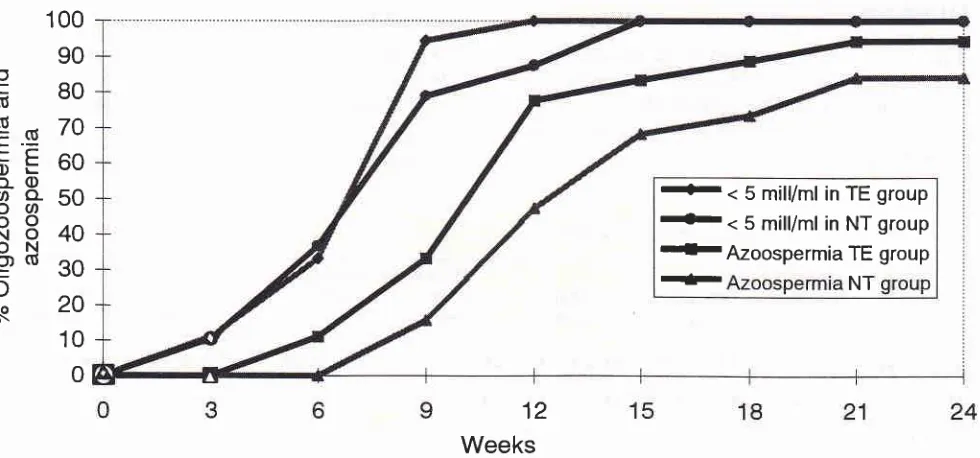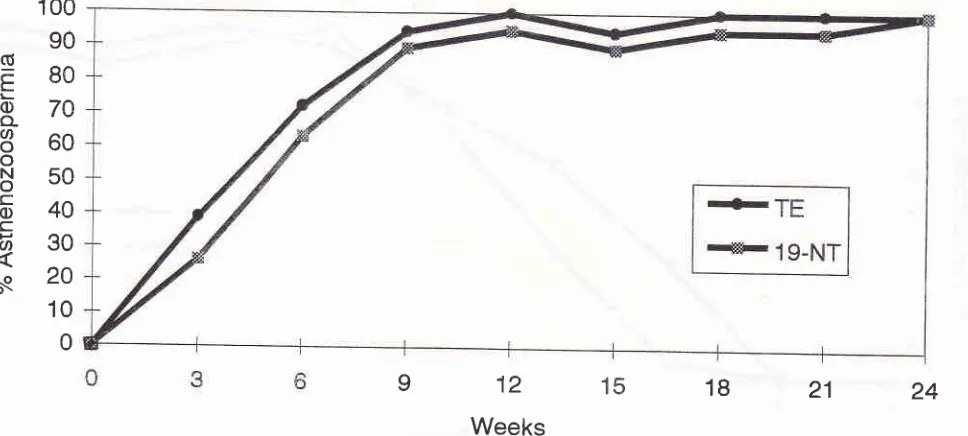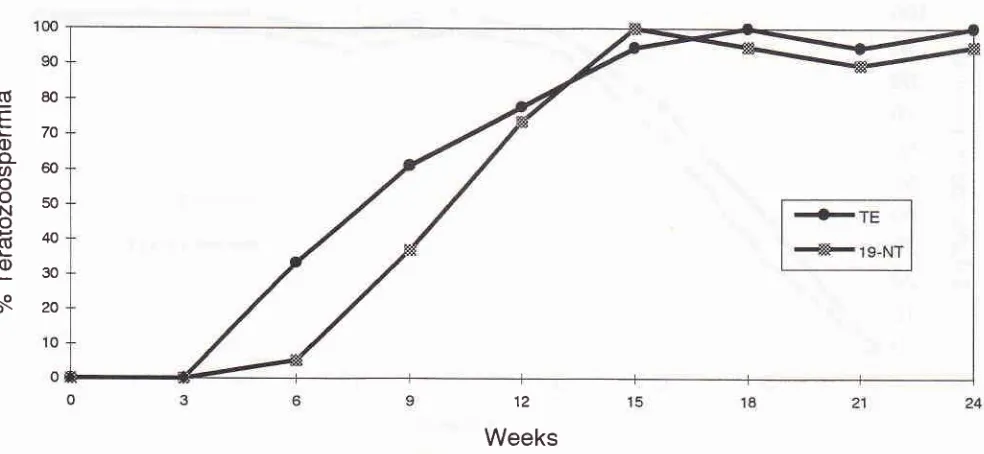t28
Moeloek Med J IndonesAzoospermia
and
Severe
Oligozoospermia
in
Indonesian
Men
Following
Injections
with
Testosterone
Enanthate
or
l9-Nortestosterone
Plus
Proges-togen
Nukman'Moeloek
Abstrak
Tuiuan penelitian ini adalah untuk nrengetahui pengaruh Testosteron enantat (TE) atau l9-Nortestosteron heksiloksi
fenil
- propionat (19-NT) ditanbah Depot nedroksi progesteron asetat (DMPA) terhadap produksi sperna pada pria Indonesia sehat. Penelitian terdiridari 2 fase yaitu fase konffol dan fase peneknnan. Enpat puluh relawan sehat disuntik 200
ng
TE atau I9-NT tiap nûnggu selattru 7 nùnggu, dilanjutkan dengan penyunlikan tiap 3 ninggu hingga ninggu ke-24. Pada kedua kelontpok tersebut disuntik 250 tttg DMPA pada uinggu ke-1, 6, I2 dan 18. Hasil ntenunjukkan bahwa tidak terdapat perubahan volune setnen, tetapi ko,tsentrasi spertna, tttotilitas daniunlah
spenna dengan nrorfologi nornnl ,,tenurun. Tiga dari 40 pria tersebut tidak dapat nelanjutkatt penelitian ini karena gagal datang pada waktu yang ditetapkan (2 orang) dan karena alasan nedik(l
oyang),tetapi
2
orangdari nerela
telah tnencapai azoospennia dan 1 orang lagi konsentrasi spernanl,a telah nencapai 0,2x
ld/nl.
Tigapuluh tiga dari 37pria
(89,2%) nrcncapai aToospenûa dalam 21 nùnggu, dengan perincian 17 dari I8 pria (94,4%) dari kelonryokTE dan 16 dari I9 pria (84,2%) dari kelottrltok I9-NT. Pencapaian oligozoospernia berat (konsentrasi spernra < 5 jutar/ntL) adalah 37 dari 37 pria (IOO%) dalan waktuI5
tttittggu. Kedua perlakuan juga efektif utttuk ntenekan ntotilitas sperna dan jutnlah spenna dengan norfologi nornnl. Kesinpulnn : AToospernia dan oligozoospennia berat yang dicapai pria Indonesia 1,ang disuntik TE atau 19-NT ditanbah DMPA lebih besar dibandingkan priaKaukasia.
Abstract
The obiective of this study is to ascertai,T the effecæ ofTestosterone enatrthate (TE) or 19 - Nortestosterone hexyloxy phenyl - propionate
(19-NT) plus Depot nedroxliprogesterone acetate (DMPA) on the senen productiotr in heabhy Indonesian nen. The prospecilve stud)l cottsisted of2 phases i.e. a control phase and treatt,rent phase. Forq' nor,,ro1 healthy nale volunteers received seven weekll, injecîiotts of TE or 19-NT,
2N ng
IM, followed by injecrion every 3 weeks îo week 24. In both groups 250 tttg DMPA wos injected IM at 0, 6,12, andl8 weeks.
The resu.lts shov,ed that there was no reduction in senten volunre, but there was a reduction in spenn concentratiot't, tttoliLil) and the nutnberof
spenn v,ith nonnal norphologyitt
both Sroups. The three of 4O nen discotttinued injections f6r f4ilnre to aftendil
scheduled tinte!2)
andfor
ntedical reaso,ts (1), but had achieved azoospernûa (2) and thethird nan
achieved spertn concentrationofO.2xld/nL.ThirrS'rhreeof3Tnten(89.2%)achievedaToosperniawithitt2lweeks,oftheselTof
lSnten(94.4%)fron
the TE group, and 16 of 19 (84.2%) from the t9-NT group. The achievenent of severe oligoToospentùa (spernt concentratiop < 5 tttiLlioty'tttL) was 37 of 37 nren(lN%)
within 15 weeks, of rheseI8
ofI8
men (100%) withittl2
weeksfrotn the TE group and 19 ofl9
nen ( 100%) within
I5
weeksfron
the l9-NT group. The two Ûeatilrcnts were aLso effectivein
suppressitrg spenn tilotili1,, and nortttsl norphology count. Conclusiotts:
The rates of aToospertnia and severe oligozoospernûa in Indonesian tttenfollowitrg injectiotu of TE or l9-NT plus DMPA are higher conqtared to the Caucasian nrcn (non Indonesian).Keywords
:Androgen,
sperm
analysis.
INTRODUCTION
Men
are
the forgotten
5O7oof
family planning. The
male
role
in family planning is often
misunderstood,and
clinical
services
focus almost exclusively
onDepartnent of Biology, Faculty of Medicine, Llniversity of In-do nes i a, J akarta, I nd onesia
women.
There
have been
no
improvements
in
malemethods
of
family planning
since
the
19th
century. I Oneof the reasons for the low participation of men
in
the
family planning program is
due
to
the
restricted
option
of male
contraceptives
made available.2The availability
of
various methods
of
contraception
makes
it
possible
for
a
person
to
use any method
desired,
so
we
may say that the more methods
thereare available,^the more
likely a
person
wili
use
aVol 5, No
j,
July - Septeurber 1996Many
researcheshave been conducted
to find
con-traceptive
agents that are botheffective
and safe.How-ever,
the development
of
methods
to
control male
fertility is more complex
thanfor women
because themale
canproduce
millions
of
spermevery day, while
a
woman releases
only
one ovum
each
month.
In
addition,
apill
orinjection for
the male should notgive
rise to
any serious sideeffects ofsexual
activity.4
Contraceptive
preparations
that have already
beenwidely
investigated
are various
combinations
of
androgen and progestog"n.s-14Specific combinations
of
androgen and progestogen
that have been
inves-tigated
are Testosterone Enanthate(TE)
togetherwith
DepotMedroxyprogesterone
Acetate(DMPA),
and 19-
Nortestosterone
hexylox;r.-
(19-NT) together with
DMPA.'''
erof
thesecombinations
has asyet
beenable to produce
a 100%consjstent azoospermia,
aneffective male
con-traceptive need not necessarily reach azoospermia, andmay be effective
simply
by
producing
a
condition
where the ejaculate
is infertile. Other
semen analysis parameterssuch
asmotility or morphology of
spermare often much more important than
the sperm
con-centration itself.
The purpose
of
this study
is to ascertain
thequantity
andthe quality of
semenproduction i.e.
spermacon-centration
mortility
and morphology
of
men
treatedwilh
Testosterone Enanthate
(TE)
or
l9-Nortesto-sterone-hexyloxy-phenyl propionate plus DMPA.
METIIODS
This study
has beenapproved
by
the ResearchEthics
Commission,
Faculty
of
Medicine, University
of
In-donesia and the Deanof Faculty
of Medicine,
Univer-sity of Indonesia.
All
subjects gave awritten informed
consentto participate.
Table
l.
The baseline physical characteristics ofsubjectsSpern Production Following Hornonal Injection
t29
This study
isdivided into
2 phases,i.e.
:control
phase(l
month before treatment) and
treatment phase
(6 months).In
the control phase
prior
to
treatment, 40 healthy
Indonesian
men between2l and 45 years
of
age
who
had
no
active
or
chronic cardiac, hepatic, renal, or
prostatic
diseasewere recruited.
Twenty
men
of
this
study were
apart
of
a WHO multicentre trial on
theefficacy
of
Testosterone Enanthate
or
l9-Nortes-tosterone
hexyloxy-phenyl-propionate plus DMPA.s
A
completemedical history
was recorded,and
aphysi-cal examination
wasperformed on
eachvolunteer.
In
addition,
venousblood (10 mL)
wastaken for routine
haematological
examination and
blood
chemistry.
Two
semen samples
were taken
2
weeks apart for
analysis.In
the treatment
phase,the
volunteers
were divided
into
2
groups
randomly,
i.e.
those
receiving
TE or
lg-NT. In
this
phase,TE 200 mg
or
l9-NT
200
mgwere injected intramuscularly
each week starting
atweek zero up
to the sixth week.
This treatment
was thencontinued every
3 weeksafter
thesixth week
upto
the twenty-fourth week, DMPA25O mg was
alsoinjected
intramuscularly
at week zero, and continued
every
6 weeks up to the
l8th. Semen analyses were
made once every three weeks.
Sem_enanallses were
conducted basedon WHO
method.rr
Baseline
values were computed as the meanof
thetwo
before
treatment values.
A two-way
analysis
of
variance (ANOVA)
was usedfor statistjcal
analysis.RESULTS
This study was
conducted
from
November
1988
toJanuary
1991,at
theDepartment
of
Biology, Faculty
of Medicine, University of Indonesia,
Jakarta.A
total
of
40 men were recruited
to
the study.
The
baselinephysical characteristics
areshown in Table
l.
Height m
Weight
kg
BMI"
Right
kg/tn-
mLMean Testis Volume Left mL
Blood Pressure
Systolic
DyastolicmmHg
mmHgTE + 19
NT
1.63r
0.05
53.95r
6.86TE
1.63t
0.05
53.2
!
5.9620.'72!
2.40
24.75x
5.1920.68
!
2.74
20.75!
5.3624.13
!
5.2324.50
!
5.45 23.'15 ! 4.97118.73
! 7.40
73.50r
4.90 120.50r 6.30
74.50!
5.22tr7.N
! 7.97
72.50!
4.33l9-NT
1.64t
0.05
54.7
! 7.77
19.86!
r.92
23.75!
4.97130 Moeloek
Table 2. The mean results of semen analyses from 37 men before and during injections of TE and 19 NT plus DMPA
Med J Indones
Volume
ml Concentration*x1o61ml
Motility*
% motil Morphology*% normal0 3 6 9
t2
l5
182l
242.58 r 0.79 2.49
!
l.L32.49
!
t.ls
2.72!
t.25 3.06r 1.08
3.04t
1.17 2.78!
t.27 2.89!
1.52 3.13r
1.4872.68
!
45.84 43.48!
36.95 13.51r
15.82 2.49!
5.96 o.73!
2.50 0.17r
0.450.11r
0.28 0.14r
0.44o.2l
!
o.8265.35
!
9.29 53.53!22.15
31.50r
23.33 15.15r
20.55 9.42!
18.47 6.92!
t7.U
2.35r
8.80 3.14t
11.20 2.35t
6.9282.10
t
4.85 76.85t
13.(X 61.35r
28.93 34.45!
34.97 16.32!
26.625.5t
!
t2.20 4.68r
13.935.tl
r
14.98 4.14t
t4.55Values are mean
t
SD*P
<0.05A
total
of
37
of
the
4Omen completed the
treatmentphase.
Of
these, 33 men(89.2%)
achievedtwo
or more consistentazoospermic
samples.The
meanresults
of
semenanalysis
from
the 37
menbefore and during
treatment
of
TE
and 19-NT
plus
DMPA are
shown
in
Table
2.Semen
volume
The
results
of
semen
volume
measurements showed that there was nosignificant difference
betweenbefore
and
during
treatment
of TE
or l9-NT
plus
DMpA (p
>
0.05)
(seeTable
2).100
90
80
70
60
50
40
30
20
10
o
Sperm concentration
The statistical
analyses showed
that there were
sig-nificant differences
in
sperm concentration
betweenbefore and
during
the
period
of
TE and
l9-NT
plus
DMPA
treatment
(P < 0.05)
(Table
2). The
rate
anddegree
of
suppression
of
sperm concentration
weresimilar
in
the group
of
TE
and
l9-NT
(P
>0.05).Cumulative
ratesof
suppression
to,azoospermia
andsevere oligozoospermia
(< 5
x
100/mL)
by
the time
since the
first injection of
Testosterone Enanthate andl9-Nortestosterone plus
DMPA,
isshown in
Figure
l.
rtr
< 5 mill/ml
inTE
group
--
<
5 mil/ml
in NT group
{rAzoospermia
TE group
-|r
NT
Ec
(U (6'=(U
L.-LF
oÈ
o-
q)oo-oUl
oo
NO
ON
o)(t
=
o
:o
o\
[image:3.595.60.550.466.695.2]12
Weeks
.q
E
L
o
o-ao
o
N
o
c
c)
-c
a
s
VoI 5, No 3, July - Septenùer 1996 Spenn Production Following Hormonal Injection 131
100
90
80
7A
60
50
40
30
2A
10
0
Weeks
Figure 2' cumulative rates of asthenoToospennia (spern motility < 5o%) by the titne since thefirst injection of rE
or
l9-NT plus DMpA24
21
18
15
12
9
Sperm
motility
The sperm
motility
showedthat
there weresignificant
differences
between before andduring
treatment ofTE
and 19-NT plus
DMpA
(p
< 0.05)
(Table
2). Therc
were
no significant
differences
in
the suppression
of
Sperm
morpholory
The
study on
thenumber
of
spermwith
normal
mor_phology
showed that there weresignificant differences
between before andduring
treatmentof TE
andlg_NT
plus
DMPA
(P
<
0.05) (Table 2).
However
there wasno
significant difference
in
the
suppression
of
the number of spermwith
normal morphology
between the groupsof TE
and
l9-NT (p
>0.05). Cumulative
ratesof teratozoospermia
(normal
sperm morphology
<
5O7o)by
thetime
since thefirst injection of TE
and19-NT plus
DMPA,
is shown
in Figure
3.Three
of
the 4O mendiscontinued injections for
failing
to
attend
at
the scheduled
times (2)
and
for
medical
reasons (1).Of
those men,two
had achieved azoosper_mia
at
weeks9
and 12with TE
plus
DMpA,
and one man achievedxl06mL, with
morphology
oAll
owere
(dataliver function test
(the onesubject who discontinued).
DISCUSSION
I
q_NTgroup
.21%) who
who
had not yet achieved azoospermia,t.".iîi ffil
sperm concentration
below
1million/ml,
and2
menwith
sperm concentrations
below 5
million/ml
(1.50
rnill./ml-
and
4.80
mill./ml).
The
achievernenr
of
[image:4.595.30.514.87.305.2].g
80c
tzo
c),t
60o
Rso
o
840
Ê30
àq
zor32
Moeloek Med J lndones [image:5.595.59.551.86.313.2]12
Weeks
Figure 3. Cumulative rates of teratozoospennia (nonnal spern morphology < 50%) by the time since thefirst injection of TE
or
l9-NT plus DMPAmen
(of
theTE
group)
had achieved azoospermia andanother
one
(of
the
19-NT group)
the
sperm
con-centration had achieved
lessthan
I
million/ml
eventhough
only
treated
for
9
weeks.
WHO
reported
thatIndonesian men treated
with TE
or
19-NT
plusDMPA,
96.7 % achieved azoospermia
(95.6ft
and 97 .8%in TE
and 19-NT group,
respectively).5
Another
study
reported that every month
injections of
TE plusDMPA
achieved
higher
rates
of
azoospermia
in
twenty
In-donesian
-"n.6
Th"
differencei may be
due
to
dif-ferent numbers
of
subjects.
In
the
Caucasian men theachievement
of
azoospermia using TE plus D.JVIPA and19-NT plus
DMPA
was less
thàn
16%.7-12 So
theachievement
of
azoospermia
in
Indonesian men
is
higher
compared
to
the
Caucasian
men.
The
dif-ferences
in
the achievement
of
azoospermia
between theIndonesian and
Caucasianmen may
berelated
todiffe-rences
in
genetic
andenvironmental factors,
in-cluding
metabolism
andnutrition.
In this study,
there was nosignificant
difference
in
theeffects
of
TE plus
DMPA
compared
to
19-NT
plus
DMPA on
the sperm concentration.
This
means thatboth
regimens have the sameeffect in
the suppressionof
sperm concentration produced
by
the
testes. Theabsence
of
significant difference
in
the lowering
of
sperm concentration between
TE and 19-NT
groupsprobably
due to the strongeffect
of DMPA in
thesup-pression
of
spermatogenesis.Furthermore,
theproges-togen and
androgen have
a
synergetic
effect on
thesuppression
of
spermatog"n".is.
16'l7
The suppression
of
FSH,
LH,
and
testosteronewhich
causessuppres-sion of
reoorted bv
severalauthors
oiotos'z'É't3'14
aswell
asIt
should
be supposedthat
thereis
no
needto
achieveazoospermia
for
a contraceptive. The numberof fertile
spermatozoa
in
the ejaculate needonly
to be reduced toa
sufficient
degree to induce consistentinfertility. It
has been proven that men treatedwith
TE
plusDMPA,
andwhose sperm concentration
was
<
5 million/ml,
the spermfunction
tests*"."
poor. l8 So the spermfunction
test
of
the
residual
spermduring
and after
treatmentshould be investigated
in
further study.
In
this
study@igure
1)atweek
L5,37 of 37men(100%)hadachieved
sperm concentration
of
<5
million/ml.
Soin
this
case, onweek
15 bothTE
plusDMPA
aswell
as 19-NT plusDMPA
possibly areeffective
as a male contraceptive.If
we investigatefurther, it
can be seen thatin
the TE plusDMPA group
100%(18/18)
had achieved sperm con-centrationof
<5million/ml
(severe oligozoospermia) atweek
12, compared tothe
19-NT groupin
which
100%(19119) achieved sperm
concentration
of
< 5 million/
mL
atweek
15
(Figure
1). Soin
this
matter,
TE
plusDMPA
may possibly be a faster contraceptive (week 12)than
19-NT plus
DMPA (week
15).In
the
Caucasianmen,
using
TE
or l9-NT
plus
DMPA
never
achieved100%
severe
million/ml)
Vol 5, No 3, July - September 1996
Sperm
motility
also
decreasedby the time
of
admi-nistration of TE
plus
DMPA
and
l9-NT
plus
DMpA.
Another
point,
the decreasing sperm
motility was
greater
in
theTE plus
DMPA
than19-NT
plus DMpAgroup,
This was caused by the greater change in
mor-phology in
the TE plus
DMPA
compared
to
the19-NT plus
DMPA
group,
sothat
the spermtail
as themain factor for
the sperm motility wasinfluenced. The
decrease
in
sperm
motility is also
repnrted
by others
who
did
study
on
TE plus
DMPA,7'8'14 as
well
asl9-NT
plus DMPA.12
Figure 2 shows that the TE plus
DMPA group achieves
100%
asthenozoospermia
in week 12,but the
l9-NT
plus DMPA groupjust achieves 100%
asthenozoosper-mia
in
week 24. This also shows that the
TE
plus
DMPA
maypossibly
be fasteras
a malecontraceptive
compared
to 19-NTplus DMPA.
This
might
be due tothe androgenic
effect
of
TE
that
is supposed
to be
greater
than l9-NT,
hence
the
suppression
of
gonadotrophin hormone by
TE should
also be greaterthan 19-NT, wtùch
causesthe decrease
in
intrates-ticular testosterone,
resulting in the
faster
decrease insperm
motility.
The
sperm
decre
ministr
DMP
The
deMPAgroup.
than 19-NT,
sticular
tes-tosterone
than
l9-NT.
It
is
already
proven
that
sper_matogenesis (pachytene)
needs testosteronà.le
Testicul
TE
showed
s andepletio
thattion
of
19-NT plus
DMpA
decreasedthe number
of
sperm
with normal morphology in
the
semenof
theexperimented volunteers.
Figure 3
shows
that the
TE
administration
canachieve
lOweek
18and
15respectively.
was
fast
mia,
sug_ility
that
ns can
beused
before week
21 as amale contraceptive.
Considering the
achievement
of
all
subjects
to
sup_Sperm Production Following Hormonal
Injection
133CONCLUSION
It
can be concluded that severe oligozoospermia
oc-curred
n
IOO%of
Indonesian men
within
12 and
15weeks after the
first
injection with Testosterone
Enan-thate
(TE)
or
l9-Nortestosterone
hexyloxy-phenyl-propionate
(19-NT) plus DMPA
respectively.
Oligozoospermia was accompanied
by a decrease
in
sperm
motility
and thenumber
of
spermwith
normal
morphology,
to
below
the
normal
limit
value.
Within
2l
weeks, the achievementof
azoospermiawas
94.4Voin the TB and 84.26%
in
the
19-NT
grouprespectively.
Acknowledgments
I
thank
Dr.
Joedo Prihartono,
MpH. and
Ir.
Budi
Susetyo,
MS.
for
their assistance
with
statistical
analyses.
I
also
thank
Mr.
Sutardjo and
Mr.
yuliadi,
technical assistants,
for performing
the semen analyses.This work was
partly supported
by
the
Special
Programme
of
Research,Development
and Researchtraining in
Human Reproduction, World Health
Or-ganization,
Geneva,Switzerland,
and
theUnited
Na_tions Populations Fund
REFERENCES
l'
Potts DM. Male contraception in family planning programs.In:
Zatuchni G, Goldsmith A, Spieler IM, Sciarraff,
editors.Male
contraception,
advances andfuture
prospects. Philadelphia: Harper&
Row, 1986:2-6.2. Moeloek
N.
Kontrasepsi pria : masakini
dan masa akan datang. Medika 1990;2:l5l-9.
3. Affandi
B
epidemiologicalstudies on
tionl.
Iaka
ePtive[disserta-4.
Penerbit
FKtII,
I 986:23.Androl 191;14:248-56.
7. Alvarez-Sanchez, Faundes
A,
BracheV,
Leon p. Attain_tosterone Enanthate as male contraceptive. Contraception 1977;15:679-91.
734
Moeloek10. Melo JF, Coutinho
FM.
Inhibition of spermatogenesis inmen
with
monthly
injectionsof
MedroxyprogesteroneAcetate and
Testosterone Enanthate. Contraception1977;L5:627-34.
11. Frick J, Danner C, Kunit G, Ioos H, Kohle R. Spermato-genesis
in
men treated combined with testosteroneenan-thate. Int
I
Androl 1982;5:246-52.12. Knuth
UA,
Yeung CH, NieschlagE.
Combinationof 19
-nortestosterone hexyloxyphenylpropionate (Anadur) and
depot-medroxyprogesterone acetate (Clinovoir)
for
male contraception. Fertil Steril 1989;5 I : 10 I I -8.13. Frick I, Bartsch G, Weiske WH. The Effect of monthly depot Medroxyprogesterone Acetate and Testosterone on human spermatogenesis.
II.
High initial
dose. Contraception1977;15:669-77.
14. Hedman
M,
Gottlieb C, SvanborgK,
BygdemanM,
Dela ToreB.
Endocrine, seminal and periheral effect of depotMed J Indones
Medroxyprogesterone Acetate and Testosterone enanthate
in man. lnt
I
Androl 1988;l I :265-?6.15.
WHO.
Laboratory manual for the Examination of humansemen and semen-cervical mucus interaction. Cambridge: Cambridge University Press, 1987.
16. Bain
J.
Androgen-progestin combinations : clinical trials. In: Cunningham R, SchillWB,
Hafez ESE, editors. Regula-tion of male fertility. London: Martinus Nijhoff, 1980:85-92. 17. Henzl MR. Contraceptive hormones and their clinical use. In : Yen SSC, Jaffe RB editors. Reproductive Endocrinol-ogy. Philadelphia, Saunders, 1986:643.18. Matsumoto
AM.
Is high dosage testosterone an effective male contraceptive agent. Fertil Steril 1988;50:324-8. 19. Steinberger E. Hormonal control of mammalian

